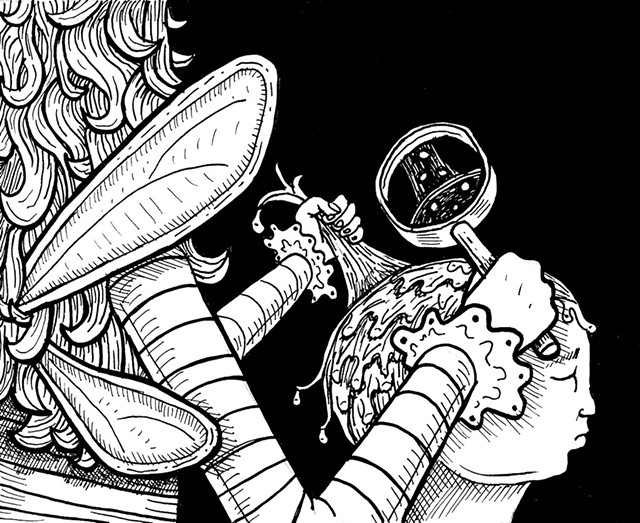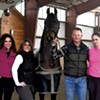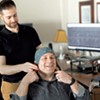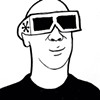Switch to the mobile version of this page.
Vermont's Independent Voice
- News
- Arts+Culture
- Home+Design
- Food
- Cannabis
- Music
- On Screen
- Events
- Jobs
- Obituaries
- Classifieds
- Personals
Browse News
Departments
-
Education

Scott Official Pushes Back on Former State…
-
News

Burlington Budget Deficit Balloons to $13.1 Million
-
Education

Senate Committee Votes 3-2 to Recommend Saunders…
- Court Rejects Roxbury's Request to Block School Budget Vote Education 0
- Norwich University Names New President Education 0
- Media Note: Mitch Wertlieb Named Host of 'Vermont This Week' Health Care 0
Browse Arts + Culture
View All
local resources
Browse Food + Drink
View All
Browse Cannabis
View All
-
Culture

'Cannasations' Podcaster Kris Brown Aims to 'Humanize'…
-
True 802

A Burlington Cannabis Shop Plans to Host…
-
Business

Judge Tosses Burlington Cannabiz Owner's Lawsuit
-
Health + Fitness

Vermont's Cannabis Nurse Hotline Answers Health Questions…
-
Business

Waterbury Couple Buy Rare Vermont Cannabis License
Browse Music
View All
Browse On Screen
Browse Events
Browse Classifieds
Browse Personals
-

If you're looking for "I Spys," dating or LTRs, this is your scene.
View Profiles
Special Reports
Pubs+More
A Professional Nitpicker Talks About Getting (and Keeping) Them Out of Your Hair
Published October 26, 2016 at 10:00 a.m. | Updated October 26, 2016 at 1:24 p.m.
When it comes to eradicating lice, there's only one guarantee: The moment you start talking or reading about them, your scalp will itch.
"Suzanne the Hair Fairy" feels it, too. After five years as a professional nitpicker — paid manually to remove lice and nits (lice eggs) from clients' hair — the 54-year-old Charlotte resident still gets a psychosomatic itchy scalp whenever she discusses her work, she says. I start scratching as we talk, too — though weeks have passed since we chemically annihilated the pests that afflicted my daughter and several classmates at Charlotte Central School.
Suzanne, who requested we not publish her full name owing to her unrelated work with Vermont foster families, delouses her clients the old-fashioned way: She removes lice and nits by hand, one at a time. It's a painstaking process that can take as long as four hours.
If the thought of picking blood-sucking vermin off the heads of family members — let alone strangers — makes your skin crawl, you're not alone. "Some people just can't handle it," Suzanne says, explaining why her clients happily fork over $100 an hour for her to pick through their kids' hair, or their own. Once she was hired to delouse the daughter of a cardiologist, who reportedly confessed to Suzanne that she wouldn't do it herself because "I don't like gross things."
Whence does this bloodsucking pestilence arise? Pediculosis capitis, aka head lice, are tiny wingless, crawling insects that dwell on human scalps and hair and feed off our blood. You can't get lice from your pets, and they can't live away from a human scalp for more than 48 hours.
"They don't jump, and they don't fly," Suzanne says. "They crawl and they're fast. And they don't like sunlight."
Children are more prone to contract lice than adults, mostly because they play and wrestle in close contact and often share hats, scarves, clothes, hair clips and brushes. Dr. Lewis First, head of pediatrics at the University of Vermont Children's Hospital, notes a relatively new mode of transmission: selfies. Everyone puts their heads together for a photo, and the bugs hitch a ride on a new host.
Adult lice are just 2 to 3 millimeters long — about the size of a sesame seed — and live for six to 27 days, according to a fact sheet from the Vermont Department of Health. During that time, the females lay about 10 oval-shaped eggs per day, which they attach to a hair shaft near the scalp using a strong, glue-like substance. When you're checking someone's head for lice and a small white speck detaches easily, it's probably dandruff or a skin flake. If it takes a fingernail to scrape off, it's likely a nit.
The nits hatch in 10 to 14 days and typically infest the hair behind the ears, the nape of the neck, even eyebrows and eyelashes. Body lice and pubic lice — i.e., crabs — are different parasites entirely. Don't call the Hair Fairy for those, as she won't pick lice below the neck.
The good news: Unlike ticks, mosquitoes and Vermont's other indigenous bloodsuckers, lice don't carry disease, making them less a public health threat than a nuisance. That said, the severe itching, which is caused by the lice's saliva as they feed on your blood twice a day, can produce secondary infections. And they can be a major hassle to eliminate.
Suzanne, a schoolteacher by training — she occasionally substitutes at Champlain Valley Union High School in Hinesburg — was introduced to nit nabbing in 1993, while working at the King Street Center in Burlington. Part of her job was to check kids' heads for lice daily as they arrived. As she explains, "I got really, really good at it."
In 2011, Suzanne spoke with a cousin in Chicago whose child had just gotten lice; a local "lice lady," she learned, was coming to remove them. The cousin suggested Suzanne set up shop in Vermont, which at the time had no professional nitpickers. She soon discovered that most major cities have salons that charge as much as $250 just to walk in the door for delousing services.
So Suzanne gave it a try, marketing herself as the "Vermont Hair Fairy." Her husband, a computer professional, created her website, but it proved superfluous. News of the Vermont Hair Fairy spread as quickly as lice themselves do, and Suzanne was soon getting calls from around the state.
Contrary to one popular misconception, she says, lice aren't more prevalent among poor people or those who don't bathe frequently. In fact, lice prefer clean hair to dirty and oily hair; if Suzanne knows several days in advance that she's going to a client, she won't shampoo beforehand.
The Hair Fairy charges for a minimum of one hour, offering a sliding scale for clients of modest means. Some clients come to her, while she visits others, charging for her travel time only outside Chittenden and northern Addison counties.
"I do it whatever I can," Suzanne says. "There's no one else who does this around here, so I feel like I'm providing a service."
There's no state certification or licensure process for professional nitpickers. Suzanne's approach — decidedly low-tech, but effective — eschews electric combs and chemical pediculicides. "They're toxic! Who wants to put that stuff on their kid's head?" she says.
Over the years, she's seen clients from all walks of life, living everywhere from mobile homes to multimillion-dollar mansions. "One mom came in beside herself because her daughter had them, and she said, 'Families like mine don't get head lice,'" Suzanne recalls. "And I said, 'Actually, anyone can get head lice. They don't discriminate.'"
Suzanne advises her clients to coat the infested hair overnight with olive oil, which suffocates the lice. When she arrives, she dons a pair of lighted magnifying glasses and gets to work, sectioning off the hair with clips, then meticulously picking through it.
Many of her clients are young children, for whom the Hair Fairy will turn on TV or a movie or — when parents are screen-averse — provide coloring books. The work requires frequent breaks, for child and nitpicker alike.
Even after she's done, the Hair Fairy can't guarantee the creepy crawlers won't come back. She instructs clients to diligently vacuum and sanitize bedding, furniture, carpets, stuffed animals, car seats and anything else made of fabric that may have touched the lice-laden locks. As for items that can't go in a dryer for at least 20 minutes, such as stuffed animals and delicate fabrics, Suzanne recommends dry cleaning them or stowing them in a Ziploc bag in the freezer for 48 hours.
Despite all her exposure to the critters, Suzanne says she's only once gotten lice herself — as a child. She recalls one close call of a different kind in South Burlington, where, during a several-hour house call, she witnessed what appeared to be drug deals. (As a teacher and mandatory reporter, she notified school officials.) But Suzanne says most of her clients are great — and grateful.
"I've also met some really amazing people," she says. When asked for names of satisfied customers, however, she balks, insisting that she must maintain clients' confidentiality. The stigma associated with lice persists.
"Carly," a mother in Charlotte, hired the Hair Fairy two years ago, after her daughter's repeated bouts with lice. While she wouldn't mind revealing her real name here, Carly says, she's chosen not to because "My daughter would be mortified!"
Carly's experience with lice was typical of many of the Hair Fairy's clients. After repeated over-the-counter chemical treatments didn't do the trick, she was at her wits' end.
"It's really traumatic for these girls," Carly says, referring to her daughter and her friends. "It's like this scourge."
After several hours with the Hair Fairy, Carly's daughter's head was louse-free. Several weeks later, when it started to itch again, the Hair Fairy returned for another quick once-over. For Carly and her daughter, both visits provided something no chemical pesticide could: peace of mind.
"She really knew what she was doing and knew what to look for," Carly explains.
Suzanne the Hair Fairy doesn't nitpick full time, but she doesn't expect Vermont's lice "scourge" to end any time soon. Despite official assessments to the contrary, Suzanne is convinced that Vermont is already experiencing so-called "super lice," which have developed resistance to over-the-counter insecticides.
What's the best part of this lousy job? Suzanne says she's met fascinating people, including rock stars whose kids picked up lice while on tour. Plus, the extra cash helps — though she doesn't do the work for lack of other skills. Over the years, Suzanne has been employed as a teacher, an aromatherapist, a graphic designer and an assistant fashion editor at Vogue magazine.
"It's not that bad, really. There's nothing dirty about it," she says of nitpicking. "It just makes your skin crawl, literally. But I'm not grossed out by it. Other people are."
Contact the Hair Fairy at [email protected].
The original print version of this article was headlined "Hair Force One"
Got something to say?
Send a letter to the editor
and we'll publish your feedback in print!
Tags: Health + Fitness, Suzanne the Hair Fairy, Vermont Hair Fairy, head lice, lice, nits, Pediculosis capitis
More By This Author
About The Author
Ken Picard
Bio:
Ken Picard has been a Seven Days staff writer since 2002. He has won numerous awards for his work, including the Vermont Press Association's 2005 Mavis Doyle award, a general excellence prize for reporters.
Ken Picard has been a Seven Days staff writer since 2002. He has won numerous awards for his work, including the Vermont Press Association's 2005 Mavis Doyle award, a general excellence prize for reporters.
Speaking of...
-

Book Review: Bugs in My Hair
Feb 2, 2016 -

What's the best way to get rid of head lice?
Dec 8, 2015 - More »
Comments
Comments are closed.
From 2014-2020, Seven Days allowed readers to comment on all stories posted on our website. While we've appreciated the suggestions and insights, right now Seven Days is prioritizing our core mission — producing high-quality, responsible local journalism — over moderating online debates between readers.
To criticize, correct or praise our reporting, please send us a letter to the editor or send us a tip. We’ll check it out and report the results.
Online comments may return when we have better tech tools for managing them. Thanks for reading.
- 1. Legislature Advances Measures to Improve Vermont’s Response to Animal Cruelty Politics
- 2. This Manchester Center Family Is a National Show Horse Powerhouse Animals
- 3. Pet Project: Introducing the Winners of the 2024 Best of the Beasts Pet Photo Contest Animals
- 4. Welch Pledges Support for Nonprofit Theaters Performing Arts
- 5. A Burlington Celebration of Nature Helps Citizen Scientists Connect With — and Count — the City's Nonhuman Residents Animals
- 6. A Former MMA Fighter Runs a Wildlife Rehabilitation Center in Cabot News
- 7. The Magnificent 7: Must See, Must Do, April 24-30 Magnificent 7
- 1. How a Vergennes Boatbuilder Is Saving an Endangered Tradition — and Got a Credit in the New 'Shōgun' Culture
- 2. Video: The Champlain Valley Quilt Guild Prepares for Its Biennial Quilt Show Stuck in Vermont
- 3. Waitsfield’s Shaina Taub Arrives on Broadway, Starring in Her Own Musical, ‘Suffs’ Theater
- 4. Video: 'Stuck in Vermont' During the Eclipse Stuck in Vermont
- 5. Pet Project: Introducing the Winners of the 2024 Best of the Beasts Pet Photo Contest Animals
- 6. This Manchester Center Family Is a National Show Horse Powerhouse Animals
- 7. Crossing Paths: An Eclipse Crossword 2024 Solar Eclipse





































